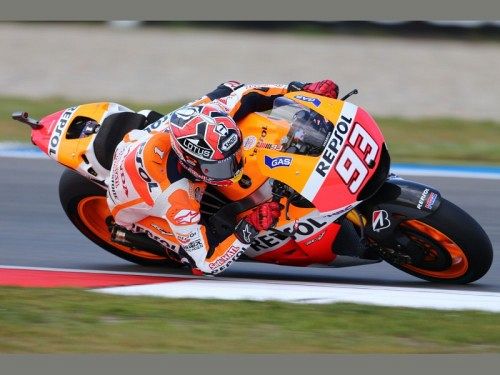Earlier this month at the end of the first MotoGP test at Malaysia’s Sepang Circuit, Repsol Honda’s Marc Marquez asked for “more traction.” In this context, the word “traction” has a specific meaning that is separate from corner or edge grip. It means the ability to accelerate rather than spin the tire.
When I saw this comment, I thought of 2005, when Honda’s riders asked for more traction, but Valentino Rossi, on a Yamaha, had no such need. Why this difference? It is a matter of rider style. The Honda men ride a modified dirt-track style, which results in what Carl Crutchlow has called, “the V-shaped Honda line.” The apex of the V is where turning occurs most rapidly. To do this more concentrated turning, the rider must go slower at the apex. To then regain this lost speed rapidly, the Honda rider needs traction to accelerate.
The contrasting style is corner speed. Its riders use “the big line,” with uniformly high corner speed all the way around. This rider depends mainly on edge grip for fast cornering, and with a more constant corner speed has less need of traction. This is why Rossi was not asking for more traction at the end of ’05.
Responding to Honda’s request, Michelin built a big, low-pressure rear tire for the 2006 pre-season tests. Initially this tire caused the Hondas to chatter, but they were able to overcome it. Yamaha, having less initial trouble with the added grip, was taken by surprise when Rossi encountered chatter in the first races. The time required to solve the chatter problem put him well down in points.
This is life at the races. Because everything on motorcycles is tightly interrelated, you can’t change just one aspect of performance without unwanted side effects. When Dorna asked spec-tire supplier Bridgestone more than a year ago to improve tire warm-up in the first three laps of races, the result seemed to favor Marquez’s modified dirt-track style and slightly reduced the edge grip essential to Yamaha’s corner-speed riders. This places less value on traditional performance variables, such as power, range, and suspension, and magnifies the importance of how fast a factory can respond to changes in tires or rules. How many new, yet subtly different, chassis can your organization design, build, and test per unit time?
It’s romantic to imagine the valiant little team, pitting its outside-the-box ideas against the big fellows, but so far in this game it’s only happened once: Casey Stoner’s 2007 MotoGP championship with Ducati and Bridgestone before the spec-tire rule.










24
Comment